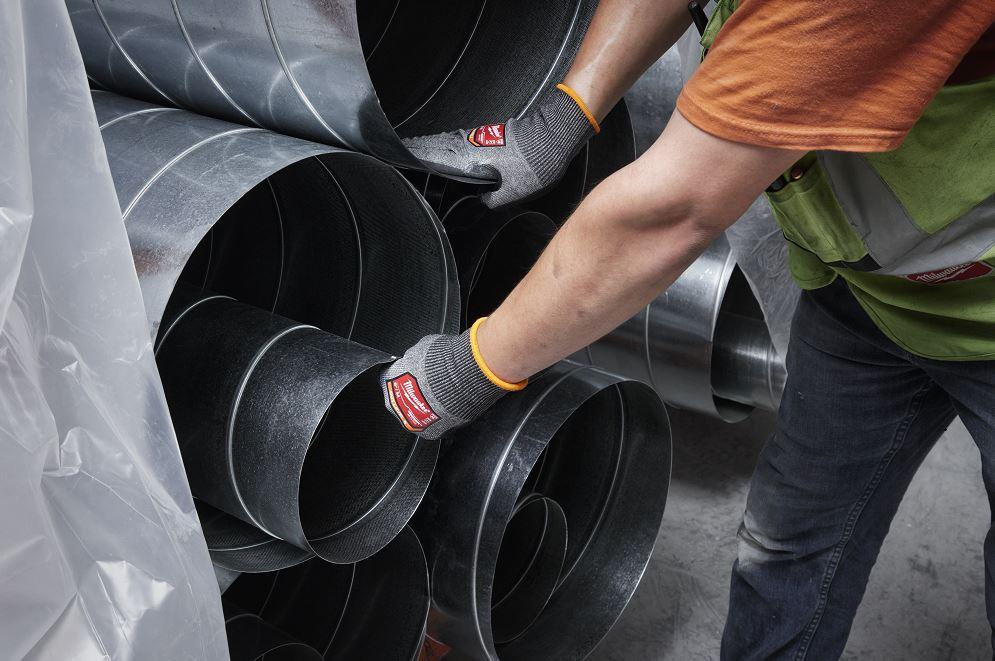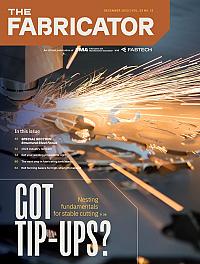Editor
- FMA
- The Fabricator
- FABTECH
- Canadian Metalworking
Categories
- Additive Manufacturing
- Aluminum Welding
- Arc Welding
- Assembly and Joining
- Automation and Robotics
- Bending and Forming
- Consumables
- Cutting and Weld Prep
- Electric Vehicles
- En Español
- Finishing
- Hydroforming
- Laser Cutting
- Laser Welding
- Machining
- Manufacturing Software
- Materials Handling
- Metals/Materials
- Oxyfuel Cutting
- Plasma Cutting
- Power Tools
- Punching and Other Holemaking
- Roll Forming
- Safety
- Sawing
- Shearing
- Shop Management
- Testing and Measuring
- Tube and Pipe Fabrication
- Tube and Pipe Production
- Waterjet Cutting
Industry Directory
Webcasts
Podcasts
FAB 40
Advertise
Subscribe
Account Login
Search
PPE extends beyond the gear for metal fabricators
Workplace safety might require a change in thinking for shop owners too
- By Lincoln Brunner
- December 14, 2023
- Article
- Safety

Kenzen’s wearable devices monitor basic bodily data such as core temperature and heart rate so employees and their supervisors can track factors that can lead to sickness or injury. Kenzen
Searching for the right personal protective equipment often means selecting gloves, breathing protection, or even personal monitoring devices for yourself or your colleagues. But it also means monitoring the awareness and attitudes toward the safety of your entire workplace—or maybe adopting a new overall ethos of personnel safety altogether.
Sizing Up the Room
Mary Ferrian, EHS/IEQ division manager for the Institute of Environmental Assessment in Brooklyn Park, Minn., focuses on indoor air quality and industrial hygiene. Ferrian oversees multiple teams, one of which conducts industrial hygiene sampling in shops and factors to better evaluate air quality and determine what kinds of contaminants are being generated during production and how the results compare to published recommendations and regulations.
“Once we have those results, we can compare [them] to the standards that exist, and that helps determine what type of respiratory protection or ventilation should be present,” Ferrian said. “It all depends on the contaminant. Say we have a carcinogen. Even though there are recommended limits, there may be some companies that don’t want their employees exposed to any level.
“In addition to comparing the industrial hygiene results to the recommended limits that exist, it’s important to look at the safety datasheet as well,” she added. “Some safety datasheets recommend wearing a respirator regardless of the controls that might be in place. It just depends on the contaminant.”
And it’s not just air quality that shops need to attend to, Kenzen CEO Kyle Hubregtse would argue. On the high-tech front, Kenzen offers an approach through its spot temperature and continuous temperature monitors that can track workers’ core body temperatures in an effort to avoid stress-related and especially heat-related injuries altogether, before they cause any real problems.
“They [shops] want to make sure it’s a safe working condition—which they’re required to do by law—and that their workers are safe and happy and healthy,” Hubregtse said. “The level of stress that they put them in will vary by job tasks and by location.
“I say stress because there’s compound stress,” he explained. “If we talk about thermal stress, or heat stress, it’s a net sum of all the stressors. It could be ambient—it’s hot and humid outside. It could be radiant heat—they’re working around molten metals. Or just by exertion or doing work—your body’s creating heat. What that does is put a strain on your body, and your body tries to deal with and thermal-regulate.”
Gearing Up
To track how well an employee’s body is regulating itself, Kenzen has created a strap-on monitor that can either act individually or tap into a local network that allows a supervisor to monitor multiple employees’ conditions at once. The idea, using core body temperature as a leading indicator, is to make sure that people are functioning at their peak level and to help them stave off heat-related injuries and illness.
“We have sensors on the outside of the device that help us with the microclimate in between the PPE, or what it is outside, and we’re utilizing those with algorithms to predict core temperature and strain and alert the individuals,” Hubregtse said.
For employees in a fabrication shop or factory, protective eyewear, ear protection, and cut- and fire-resistant gloves are often everyday must-haves. One of the latest advances in gloves are Milwaukee Tool’s high-dexterity nitrile dipped gloves in ANSI/ISEA cut levels 6, 7, 8, and 9.

Milwaukee Tool’s nitrile gloves are designed to promote maximum dexterity while not sacrificing safety. Milwaukee Tool
These gloves and others on the market not only protect welders and people handling parts with sharp edges, but they also enable users to use touchscreens without sacrificing protection in the process. The gloves feature a reinforced nitrile coating between the thumb and index finger and are made of an 18-ga. material, which allows people wearing them to complete smaller tasks without removing them.
“Most hand injuries happen when users are not utilizing gloves, so Milwaukee aims to design gloves that are more dexterous and comfortable,” said Austin Dorman, senior product manager at Milwaukee Tool. “Ultimately, these gloves were designed to allow users, such as fabrication workers, to stay better protected when working with sharp materials without sacrificing mobility. The design allows users to operate more efficiently and safely.”
Individualizing Protection
Though many pieces of gear are ubiquitous—one thinks of gloves in a welding shop—PPE is not a one-size-fits-all enterprise, especially when it comes to head and face gear.
“There can be a challenge with respirator use and safety glass use at the same time—sometimes that can be difficult, depending on the fit and size of the person’s face,” Ferrian said. “Maybe the individual only needs a half-mask respirator to protect against the contaminants, but we may go to a full-face respirator if they’re not able to effectively wear the half mask and the safety glasses at the same time, because the full-face respirator provides that eye protection as well.”
Hubregtse noted that a manager who’s monitoring a group of employees may notice that one individual is exceeding their personal heat threshold or that their heart rate is too high. In that case, it’s up to the manager to intervene based on that person’s individual factors.
“The No. 1 thing is they need to take an individual approach,” Hubregtse said. “One of the bigger challenges in the industry is there tends to be a one-size-fits-all approach in a number of different ways, from a regulatory framework but also [in] company policy.”
Regarding company policies and procedures, Ferrian noted that communication between employers and employees is absolutely key to success—especially when it comes to gray areas where employees who feel the responsibility to complete certain tasks are tempted to bend rules to do so, without telling their bosses. For example, there may be a permit-required confined space that an employee needs to enter to do an assigned task, but he doesn’t have the permit and doesn’t bother to bring it up to his supervisor.
The answer isn’t just “Git ‘er done.” It’s finding a solution that makes everyone happy and follows regulations.
“I’ve seen employees do things they think maybe they shouldn’t do, but they want to get the job done,” Ferrian recalled. “So instead of talking to their supervisor or safety manager about developing a safety plan, they just do it.
“If I’m involved in managing a safety program or working with employees at a client site, I really want to make sure they know, ‘This is our rule—I don’t want you to do this. But if you think you have to for some reason, let’s talk about it and see what the best solution is. We don’t want to hold you up from getting a job done, but let’s talk about it. Let’s see if there’s a contractor we can bring in who has a permit-required confined space plan—or maybe we just need to develop a one-time plan for you to be able to go into that space.’”
That kind of proactive communication not only keeps people safe, it can change a company’s long-term overall culture for the better. Whether it’s through a device or just a habit of communicating better, it benefits everyone.
“If you wear a device frequently, you get to know how your body reacts—like, ‘Oh yeah, this is how I’m feeling before I start to get ill,’” Hubregtse said. “So, as a worker, you start to figure it out a little bit more. You can pay a little closer attention to how your body’s operating. And then I think it does [result in] a company improving the worker output and safety mechanisms or overall safety on the worksite.
“If the employee is paying attention, [they see] the employer is investing in their health. That changes the relationship. That should improve the relationship a little bit to say, ‘Hey, we’re taking an interest in it. We’re not spying on you. This is for you to make sure you’re healthy.’ I think that’s a pretty good benefit, an unsung benefit.”
About the Author

Lincoln Brunner
2135 Point Blvd.
Elgin, IL 60123
(815)-227-8243
Lincoln Brunner is editor of The Tube & Pipe Journal. This is his second stint at TPJ, where he served as an editor for two years before helping launch thefabricator.com as FMA's first web content manager. After that very rewarding experience, he worked for 17 years as an international journalist and communications director in the nonprofit sector. He is a published author and has written extensively about all facets of the metal fabrication industry.
Related Companies
subscribe now

The Fabricator is North America's leading magazine for the metal forming and fabricating industry. The magazine delivers the news, technical articles, and case histories that enable fabricators to do their jobs more efficiently. The Fabricator has served the industry since 1970.
start your free subscription- Stay connected from anywhere

Easily access valuable industry resources now with full access to the digital edition of The Fabricator.

Easily access valuable industry resources now with full access to the digital edition of The Welder.

Easily access valuable industry resources now with full access to the digital edition of The Tube and Pipe Journal.
- Podcasting
- Podcast:
- The Fabricator Podcast
- Published:
- 04/16/2024
- Running Time:
- 63:29
In this episode of The Fabricator Podcast, Caleb Chamberlain, co-founder and CEO of OSH Cut, discusses his company’s...
- Trending Articles
Tips for creating sheet metal tubes with perforations

Are two heads better than one in fiber laser cutting?

Supporting the metal fabricating industry through FMA

JM Steel triples capacity for solar energy projects at Pennsylvania facility

Omco Solar opens second Alabama manufacturing facility

- Industry Events
16th Annual Safety Conference
- April 30 - May 1, 2024
- Elgin,
Pipe and Tube Conference
- May 21 - 22, 2024
- Omaha, NE
World-Class Roll Forming Workshop
- June 5 - 6, 2024
- Louisville, KY
Advanced Laser Application Workshop
- June 25 - 27, 2024
- Novi, MI


























